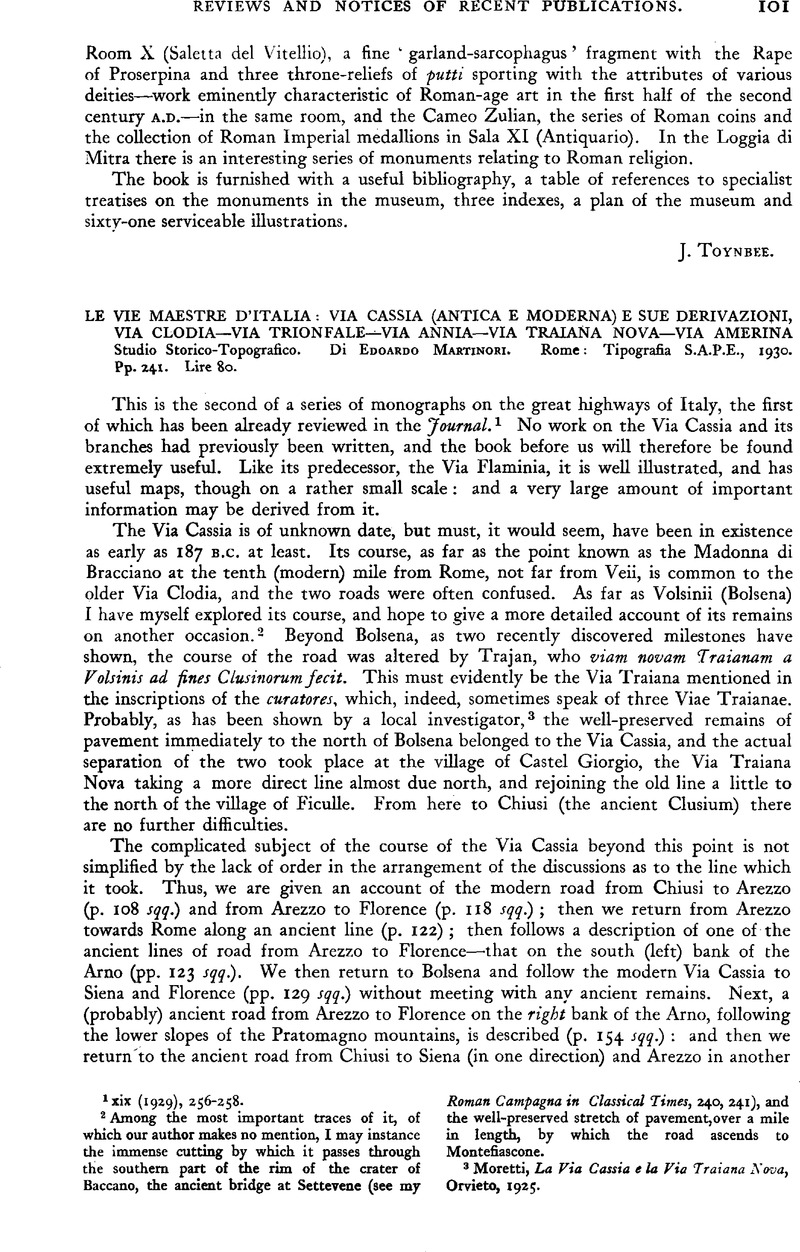No CrossRef data available.
Article contents
Le Vie Maestre d'Italia: Via Cassia (Antica e moderna) e sue derivazioni, Via Clodia—Via Trionfale—Via Annia—Via Traiana Nova—Via Amerina Studio Storico-Topografico. Di Edoardo Martinori. Rome: Tipografia S.A.P.E., 1930. Pp. 241. Lire 80.
Published online by Cambridge University Press: 24 September 2012
Abstract

- Type
- Reviews and Notices of Recent Publications
- Information
- Copyright
- Copyright ©T. A. 1930. Exclusive Licence to Publish: The Society for the Promotion of Roman Studies
References
page 101 note 1 xix (1929), 256–258.
page 101 note 2 Among the most important traces of it, of which our author makes no mention, I may instance the immense cutting by which it passes through the southern part of the rim of the crater of Baccano, the ancient bridge at Settevene (see my Roman Campagna in Classical Times, 240, 241), and the well-preserved stretch of pavement,over a mile in length, by which the road ascends to Montefiascone.
page 101 note 3 Moretti, , La Via Cassia e la Via Traiana Nova, Orvieto, 1925Google Scholar.
page 102 note 1 Allusions to it have already been made (pp. 112 sqq., 126).
page 102 note 2 Ad Cluv. p. 569, 1. 31, which I have already republished in Studi Etruschi, iii. 184, n. 2, and repeat here:
‘Cum Via Cassia per planitiem ducat iuxta Clanin Fl. ubi nunc quoque vestigia eius passim visuntur, quamvis maxima pars ob Clanis inundationes obtecta sit. … Statuae … illae Antonini sive Novae Tabulae Peutingerianae, si modo unus idemque locus est, eo loco fuere, ubi via quae Sena Perusiam ducit Cassiam intersecat (Acqua viva) haud procul cis Pontem Valiani, ut sequens ille ad Graecos haud procul Foiano iuxta pontem Granaioli (Ponte di Cortona) qua itidem transit via, quae Sena Cortonam ducit. Ita quoque tertius ad Ioglandem, qua via Sena Arretium ducens eandem Cassiam intersecat (Pieve al Toppo). Nam circa hunc locum veteris Cassiae vestigia in suis praediis se deprendisse mihi testatus est illustrissimus Thomas Salvatius Arretinus Episcopus.' Sheet 121 of the Edizione Archeologica della Carta d'Italia al 1: 100,000 (Montepulciano) and sheet 23 of the Carta d'Italia del Touring Club Italiano (Perugia) may be profitably consulted.
page 102 note 3 Mélanges, xxxi (1913), 234Google Scholar. sqq.
page 102 note 4 Studi Etruschi, iii, 175 sqq.
page 102 note 5 Our author is unnecessarily vague on the subject: on p. 172 he rightly states that the ancient road to Bracciano is followed by the modern: but on p. 177 he says ‘The Clodia must have shared with the Cassia the section from ad sextum (Sepoltura di Nerone) to Vacanae (Baccano), from which point it turned off to Forum Clodii passing by Sabate (Trevignano).’ There is, however, no doubt that the Clodia kept on the west of the lake of Bracciano.
page 102 note 6 Studi cit., p.182, n. 3.
page 102 note 7 It seems hard to believe that Castellum Amerinum was on the right bank of the Tiber, as our author thinks. See Nissen, Landeskunde, ii, 400, who places it on the left bank opposite Orte.




